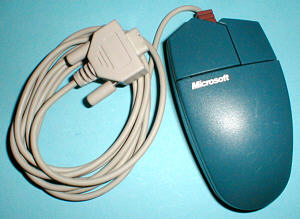Label on the bottom of a Microsoft InPort™ bus mouse, showing the FCC ID 'C3K7PN9937' In the late 1980s, mice were not integrated with IBM-compatible personal computers, and the specialized bus interface (implemented via an ISA add-in card) was one of two popular ways to connect a mouse. (Serial interfaces. A Microsoft InPort bus mouse adapter, in the form of an 8-bit ISA (XT-bus) card. XA/XB and YA/YB indicate movement and direction based on quadrature phase. A bus mouse is a variety of PC computer mouse which is attached to the computer using a specialized interface (originally.
Microsoft Serial Mouse 2.0
| Manufacturer | Microsoft Alps Electric (contract manufacturer) |
|---|---|
| Type | Mouse |
| Release date | May 2, 1983 |
The Microsoft Mouse is a computer mouse released by Microsoft in 1983. It is the first mouse released by the company, and it was bundled with Microsoft Word, Notepad, and an on-screen teaching tutorial for an initial price of $195.[1][2]
Nicknamed the 'green-eyed mouse', the Microsoft Mouse featured a pair of green buttons. It also featured a more curved body than the blockier designs more common of mice at the time. As with other mice at the time, the Microsoft Mouse used a steel ball for tracking.[3]
The initial version featured an InPort ISA interface, requiring a Microsoft bus card to be installed in the computer. Later versions were available with DE-9 or DB-25serial connectors. All versions of the Microsoft Mouse could be used with IBM-compatible and other MS-DOS systems.[4][5][3]
Later Microsoft mice[edit]
In 1985 Microsoft introduced the 'gray-eyed' Microsoft Mouse, featuring a higher resolution than competing mice. In 1987 the 'dove bar' Microsoft Mouse was introduced, compatible with both serial port and PS/2. In 1991 a ballpoint Microsoft Mouse was made. The 'kidney' Microsoft Mouse 2.0 was introduced in 1993, and its design served as the basis for the IntelliMouse, which debuted in 1996.
A PS/2-compatible Microsoft Mouse 2.0
A serial-compatible Microsoft Mouse 2.0
References[edit]
- ^'The good, bad and ugly history of Microsoft hardware'. PCWorld. Retrieved 2017-05-04.
- ^Weber, Harrison (2012-05-28). '30 Years of Microsoft Hardware: From Mice to Men'. The Next Web. Retrieved 2017-05-04.
- ^ ab'Microsoft Green Eyed Mouse ~ o l d m o u s e .c o m ~'. www.oldmouse.com. Retrieved 2017-05-05.
- ^'Microsoft Mouse - 1983'. toastytech.com. Retrieved 2017-05-04.
- ^'The History of Microsoft - 1983'. Channel 9. Retrieved 2017-05-05.
Microsoft Mouse Timeline
1982 Microsoft launches into hardware design to develop a mouse.
1983 the first Microsoft 'green-eyed' Mouse
1984 Microsoft branded a custom hybrid mouse for Xerox; invented the first serial mouse
1985 Microsoft 'grey-eyed' Mouse 5.0
1987 Microsoft 'dovebar' Mouse
1988 Microsoft sold its one-millionth Mouse.
1988 Microsoft Serial-PS/2 Compatible Mouse, clear.

1989 Microsoft Mouse sales passed 2 million units, and Microsoft was awarded a patent for internal mouse technology.
1991 Microsoft BallPoint Mouse
1993 Microsoft 'kidney' Mouse 2.0
1994 Microsoft Home Mouse and IntelliPoint software. Microsoft shipped over 5 million Microsoft Mouse 2.0
1995 The award-winning Microsoft EasyBall was introduced, the first computer mouse designed for children.
1996 Microsoft Intellimouse with scroll wheel
1997 Microsoft IntelliMouse Trackball
1998 Microsoft IntelliMouse Pro
1999 Microsoft Intellimouse Optical
2000 Microsoft Trackball Explorer and Microsoft Trackball Optical
2001 Wireless Intellimouse Explorer
Ms Serial Ballpoint Mouse Disabler
2002 Wireless Optical Desktop for Bluetooth
2006 Wireless Laser Mouses